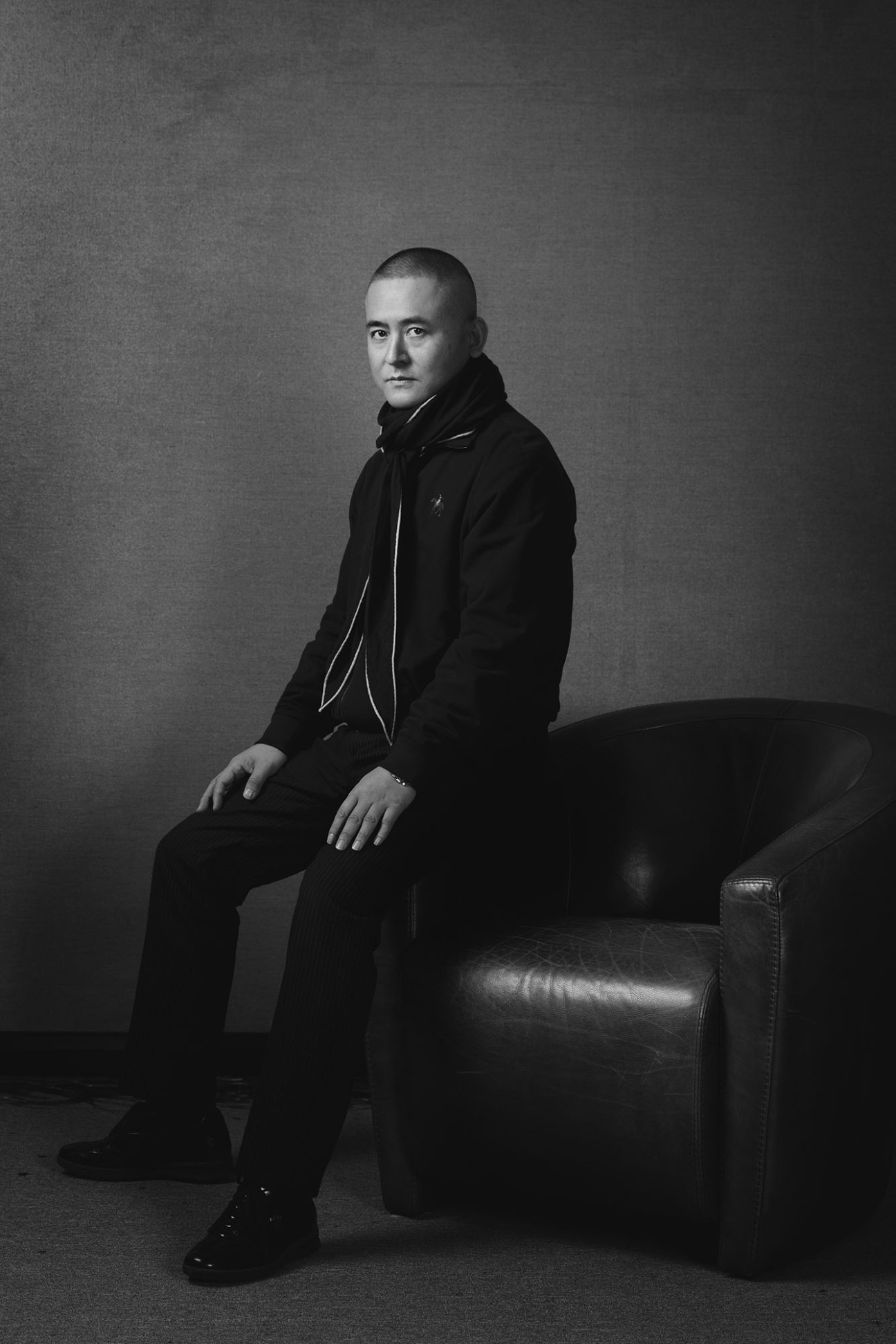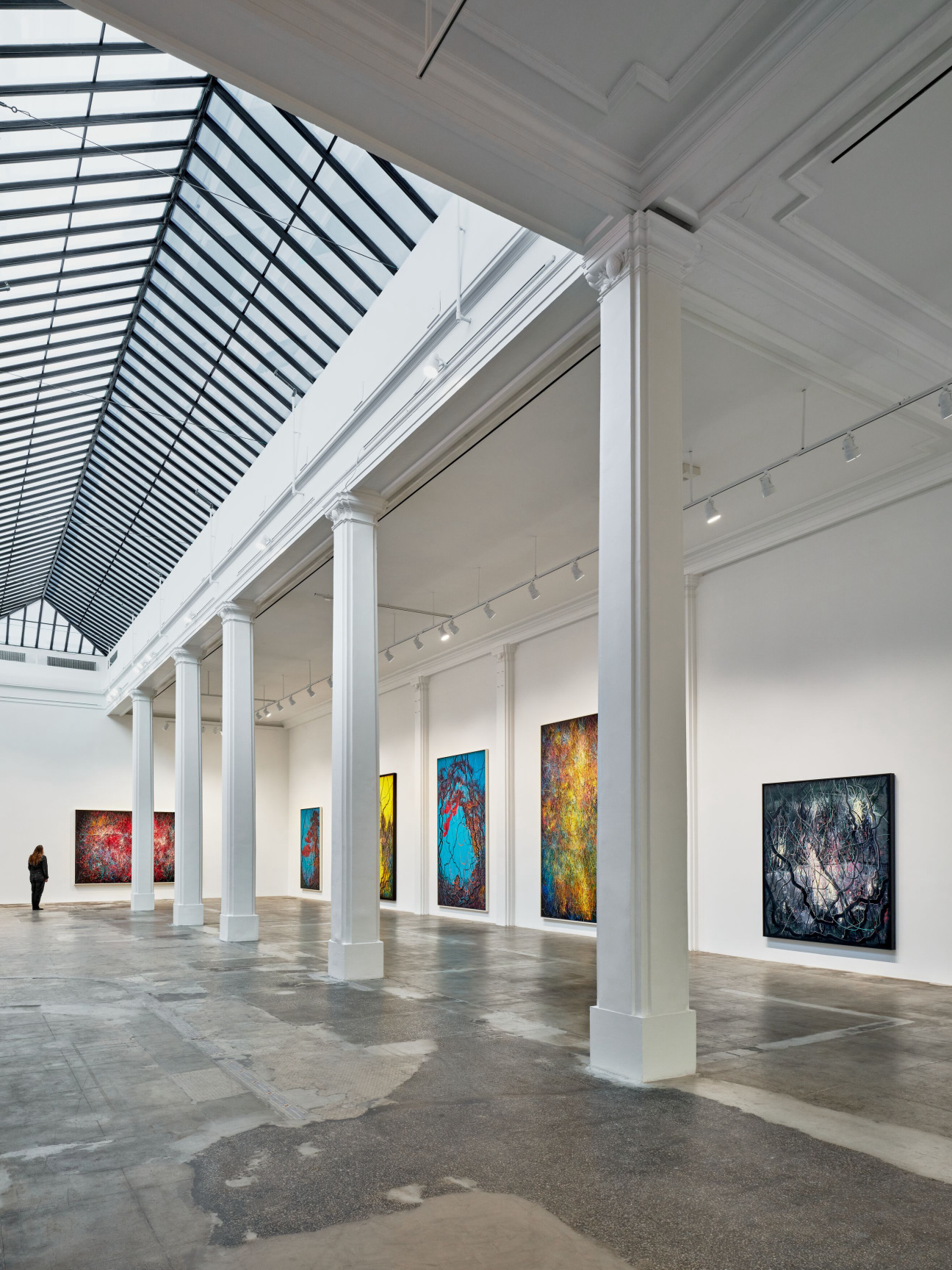
From the mezzanine level of Hauser & Wirth's South Gallery, Zeng Fanzhi—armed with a top-of-the-line iPad—is photographing his exhibition from above, zeroing in on the interaction between the gallery lights and the paint, noting the precise spacing of each canvas between the hall’s stately columns. It’s the day before the February 2 opening of Zeng's self-titled exhibition—his first solo show in Los Angeles.
The ten paintings—not including the six smaller graphite sketches also on display—were all created in the last few years. “For me, the small black one is the most important piece in the exhibition,” Zeng says through his translator. “It offers an anchor of comfort and balance to the eyes of the spectator.” The series of synaptic abstractions, some over ten feet tall, bristle with shocks of color, emitting a crackling energy that makes the gallery hum even before it opens to the public. The paintings are inspired by landscapes, conjuring the feeling of peering through brush or tumbling down ominous rabbit holes. “The paintings make you tilt your head back. It’s like a religious experience,” he says. But for Zeng, the paintings function more as studies in brushwork technique than as a thematic exploration. The Beijing-based artist is a dedicated follower of Cezanne, and has developed his own painstaking approach to mark making based on his decades-long research into the techniques of the Old Masters and Impressionists. With each body of work, his methods evolve.
One of China’s most renowned living artists, Zeng has visited LA a few times—first as a young artist eager to take in the city’s rich art scene, and again in 2019 as an established artist with Hauser & Wirth representation, eager to connect with local collectors. But this time, Zeng is nervous—within 24 hours of touching down at LAX after the long flight from Beijing, he was in the gallery. “I won't know the results of this work until I see the response of the local population,” he says.
For Zeng, the precise orientation of the works on the wall might be as important as the works themselves. “What does the painting do in the space? That interests me,” he says. We talk for some time about his painting practice, but when our discussion moves to the curatorial process, the artist’s face lights up. His ivy-covered Beijing studio features a private exhibition space—complete with polished onyx floors and featuring a single chair—where Zeng experiments with the intricacies of display, spending hours seated before his canvases. At one point in our conversation, Zeng proffers the iPad again, scrolling through a camera roll packed with close-cropped shots of a new pointillist-cum-pixillation brushwork technique he’s currently testing on a series of yet-unnamed paintings—wavelike layers of black paint that catch the light, creating the illusion of frothy white crests. He slides his thumb to the next image with a satisfied smirk, revealing the same canvas under different lights, completely transformed. For this exhibition, Zeng built a 3D model of the South Gallery at 1:10 scale, which he’s pored over since July—arranging and rearranging his miniature works, imagining how people might flow through the room.

The artist’s practice encompasses distinct figurative and abstract oeuvres. In his three-part exhibition in 2018, which took place across Hauser & Wirth’s Hong Kong, Zurich, and London galleries, Zeng presented his large-scale abstracts, portraits, and traditional calligraphic illustrations as worlds of their own. But Zeng’s portraits are not as isolated from his eerie abstract portals as they might seem: “Most people would say figuration and abstraction are completely different, but I disagree,” he says. “To me, they feel connected. They have an impact on one another.” For Zeng, they represent points on a feedback, a perspective that allows his adoration for technique to reveal itself at every level—resulting in enormous works that are as captivating on an iPad as they are from a mezzanine.
When asked about the throughlines that connect such a varied body of work, he resists the premise. “This is a show about painting, about experimentation,” he asserts. “It’s about the questions I pose to myself,” he pauses. “And already, standing here in the gallery, I’m asking myself new ones.”
"Zeng Fanzhi" is on view at Hauser & Wirth’s Downtown Arts District location until April 30 2023.




